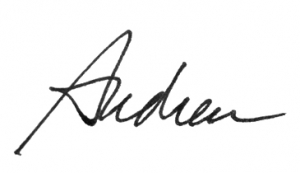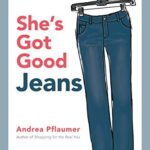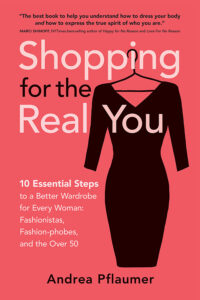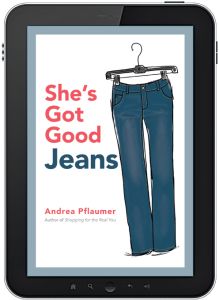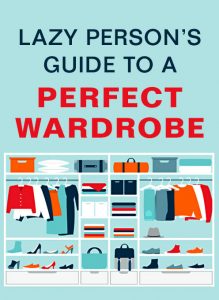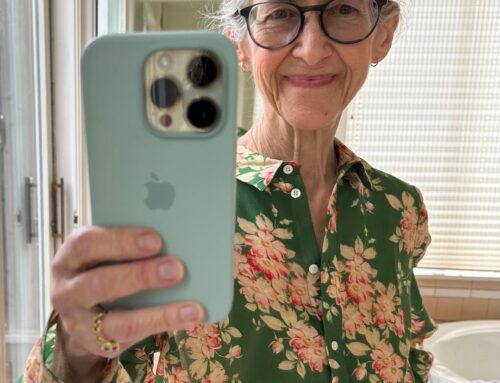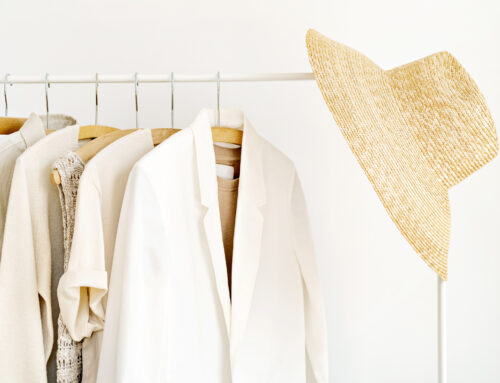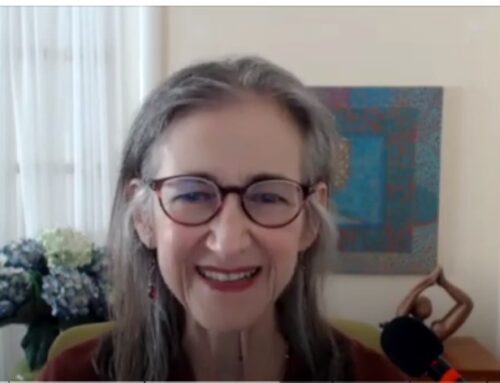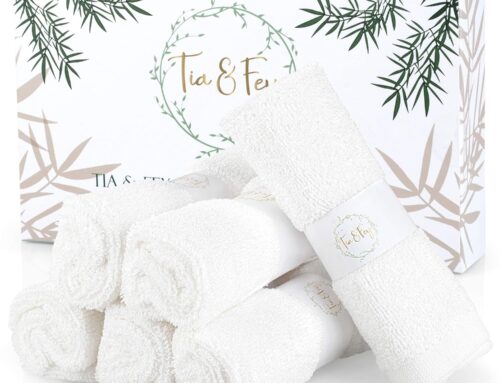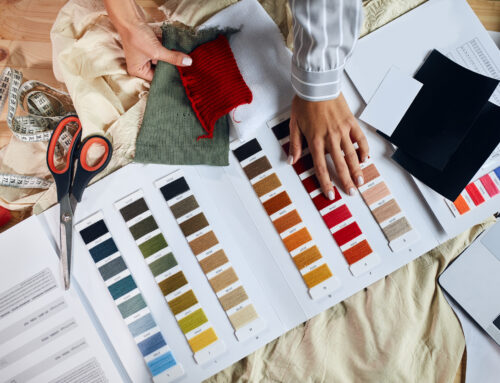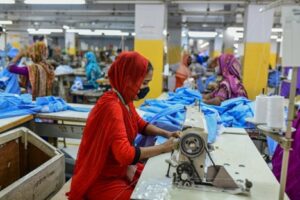
Photo courtesy of Open Society Foundation
I just received an email from a woman I follow on YouTube. It was filled with multiple “mea culpas” and deep apologies for promoting so-called “fast fashion” for years. She pointed to the unhealthful environments and working conditions at factories in many emerging countries, and to the environmental impact of the industry as a whole.
The increasingly popular – and important – pivot to sustainable fashion is something I’ve written about in several previous posts. On an independent industry analysis website, goodonyou.com, there are several companies (H&M, SHEIN, etc.) that were initially rated extremely low, based not only on how their suppliers treat their workers, but for the material content of their products.
I discovered that many of the small “alternative” design houses and manufacturers, to whom they gave high marks, offer very limited styles and sizes and/or are much, much more expensive. Certainly, some of these small companies should be looked into. (A bunch of them were overseas, I noticed.) I suspect the site is working in partnership with a lot of those fledgling companies. But I definietely wish them all well. Still, let’s examine the situation further.
Couture vs. Low-End
Paying workers a living wage, using natural textiles, and limiting production will make fashion a lot more expensive. For us consumers, the material benefit of higher-end fashion is that we’re likely to get more longevity out of an item and the textiles are often more elegant and durable. Also, the finishes will be better: seams, linings, buttonholes, etc. That’s why buying vintage or re-sale couture is often the first choice for shoppers concerned about ethical solutions to the industry’s problems.
We would think that couture houses are more likely to employ more local workers and pay close attention to the supply chain. But even so-called “sustainable” fashion houses and even some of the high-end couture brands are using third-world factories whose workers get paid a fraction of domestic wages. Also, several high-end couture handbags are now being manufactured in China.
Frankly, much of designer fashion reflects the ultra-cutting edge of current style. That’s one of many reasons I repeatedly encourage having simple, classic, basics in everyone’s wardrobe. And well-made classic basics are available at many sites for a whole lot less than what you would pay for from a high-end label.
The Problems with Low-Cost Fashion
Most of the complaints about a lack of sustainability in the fashion industry surround the wasted materials and resources from over-production and environment toxins from dyes and processes like “distressing” jeans. (I wrote about this in my ebook “She’s Got Good Jeans.”) Sadly, human rights abuses – particularly of the women – in factories gets a lot less exposure in the analyses, for some unknown reason.
So, what does sustainability really mean? And does good quality have to be expensive? Thankfully, some of the middle tier and even lower end companies are pretty good on the sustainability issue. Because I own several items from so-called fast-fashion companies, which I am sharing here, I felt compelled to do some research about how they are tackling the issue. The findings were fairly hopeful. Here are a few that I looked into and that I have bought from in the past year.
GAP
When certain images pop up in my Facebook feed, I feel a compulsion to click. One site that never fails to hook me is GAP. For starters, they offer classic, simple, well-made basics for sometimes ridiculously low prices. (I have t-shirts from GAP that are over 15 years old.) And they carry a huge range of sizes including petite and plus and they have some crazy big sales.
But when I had my GAP cart filled with a great sweater and some organic cotton tees, those images of the women working in their factories invaded my mind and gave me pause.
GAP has been on the crosshairs of many human rights and environmental institutions for nearly a decade. So, I was encouraged when I found this recent report in my research:
“Gap Foundation, in partnership with vendors and non-governmental organizations, launches the P.A.C.E. (Personal Advancement & Career Enhancement) program, which teaches life and work skills to women who work in the garment factories where our products are made.”
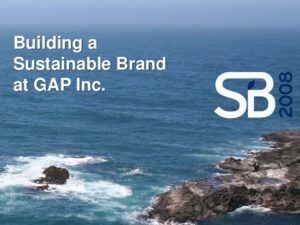 As for human rights, their corporate site pledges that by 2025 “100% of factory workers will have representative workplace committees, gender parity among supervisors, and vigorous prevention/response management systems” in place to quickly address the shocking amount of gender-based violence in the industry.
As for human rights, their corporate site pledges that by 2025 “100% of factory workers will have representative workplace committees, gender parity among supervisors, and vigorous prevention/response management systems” in place to quickly address the shocking amount of gender-based violence in the industry.
In their most recent update, it looks as though they pretty well on their way to achieving those percentages.
Does this indicate that there are no longer abuses in the industry? No. But the pressure on these companies, and just about all of them in the lower-end price category, is not going to let up. That’s a good thing.
[NOTE: Based on the extreme and frequent sales offered by many of the “fast-fashion” brands, it seems they are still struggling, while trying to strike a balance between satisfying their investors, and doing right by their suppliers’ employees. GAP recently had to lay off hundreds of high-level executives. SHEIN just invested more than $15million to investigate and improve conditions in their overseas factories. But SHEIN is still manufacturing a lot of clothing with microplastics that end up in the landfill, our water, and the marine ecosystem.]
Quince
I’ve mentioned this company several times recently. Quince came on the scene about 5 or 6 years ago and must have one heck of a design team. They keep coming up with things that look very much like currently fashionable higher end basics (fisherman sweaters, silk blouses and skirts, organic cotton separates, cashmere cardigans and pullovers, trending classic handbags, etc.) for sometimes one-fifth the typical price. So, I tried to do some digging about how they fare on the sustainability level.
Their corporate verbiage is slightly “hype-y” but here’s how they address the topic.
Quince was built with sustainability in mind. We partner with factories we know and trust. In China, where our cashmere is assembled, we work with a factory whose relationship with one of our co-founders spans more than 20 years. And the factory has worked with the same goat herders in Inner Mongolia for the past 30 years. In Italy, we work with a small factory run by two brothers who have been in business for more than 20 years. They create leather goods using small-batch production and their “factory” looks much more like an atelier run by a handful of master craftsmen who have spent a lifetime working with leather!
We work with world-class factories that are supplying products to the top brands in the US and EU. All of our factories are compliant with ILO standards, paying fair living wages and working conditions. You will see from the transparent pricing available on each product’s page that transparency matters a lot to us!”
So far, I haven’t discovered that they have been vilified or targeted by environmental organizations. Considering their visibility, I take that as a hopeful sign. The European Linen wide leg pants on the left here are one of my latest purchases. They come in several neutral colors. Super comfortable and like all their items so far, really well made.
MANGO

Mango bomber jacket
This is a Spanish company that has been extremely popular in Europe but is now also available in the US. I ordered this yellow bomber last year, but they don’t seem to have it in stock any longer. They have a really cute similar denim one now.
I also have a two-piece outfit green top and bottom set (I call it “garage mechanic chic”) last year and consistently get compliments on it. It is 100% cotton and I wear it with a belt I bought about 25 years ago. It’s also sold out. (When they offer a big sale things go quickly. At end of season they often have 70% off sales.)
Mango tends to be hipper and more fashion-forward than a lot of fast-fashion US brands. Plus, their inventory is enormous – slightly overwhelming, actually. There’s something for everyone. And they feature a lot of things, including accessories, that rival materials and designs from higher-end design houses.
They prominently display their commitment to sustainability and a mutually cooperative relationship with their factory workers on the public website. On the corporate site they go into much more detail, but it’s in Spanish. (It gave me a chance to dust off my Spanish – I had to look up a few words.) They list all the factories they use – in fact they were the first large scale company to do this – and have a pretty extensive materials sourcing section.
EVERLANE
I started featuring Everlane several years ago because of their natural fiber clothing, transparency in pricing, and treatment of their factory workers. They were probably the first company that vigorously addressed their workers’ health and environmental concerns from the get-go. And their prices were very reasonable for the quality of their items.
They offer well-made contemporary and classic basics that have longevity and style. I’ve found that in the last couple of years their things got a little too boxy and shapeless looking, (as is a lot of the style lately) but their pants seem to be excellent. In the photo below I’m wearing a pair of white wide-leg jeans that I bought from them recently. They sold out of the wide leg, but here is their straight-leg version. (GAP has a wide-leg version here.) The super comfy sneakers in that photo are from Josef Seibel and although they don’t seem to offer the yellow ones any longer, they still come in a bunch of wonderful colors.
H&M
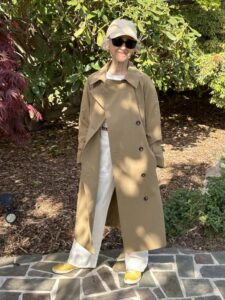 I have been looking for a trench coat for years. I already had one – a fabulous long navy blue all cotton one from GAP – that I bought years ago. It hung in my closet for about two years, unworn. Last fall I finally got it hemmed and wore it constantly. But I’ve been wanting one in the tan or khaki range. (They seem to be out of this one, but have several others here.)
I have been looking for a trench coat for years. I already had one – a fabulous long navy blue all cotton one from GAP – that I bought years ago. It hung in my closet for about two years, unworn. Last fall I finally got it hemmed and wore it constantly. But I’ve been wanting one in the tan or khaki range. (They seem to be out of this one, but have several others here.)
I rarely, if ever, shop at H&M. Some of the stories I heard about their human rights and materials abuses scared me off.
But I just found this:
“For the eighth year running, H&M was included in the Dow Jones World Index. We ranked fourth in 2020, with a score of 70/100. In addition, we were listed in the Dow Jones European Index with the highest possible score for human rights, environmental reporting, social reporting, and materiality. We also reached the highest score in our industry for supply chain management and strategy for emerging markets.
FTSE4Good
H&M has qualified to be a part of the FTSE4Good Index Series. This means that, based on independent assessments, we can demonstrate and measure strong environmental, social and governance standards.”
So on my birthday shopping trip this year I found two things there that had been on my shopping list for ages. It’s rare for me to find any item that fits perfectly, especially as a petite. And although I never wear anything made from polyester I make a rare exception for something I will wear away from my skin. That trench coat was too good to resist. I also found a navy blue blazer – not boxy and long (as a petite those make me look a little clownish) – that fit absolutely perfectly. It’s 100% poly. It will outlive me. That, the trench, and a rain shell are the only polyester pieces in my wardrobe.
Personally, I admire women who buy maybe three high-end items each year, nothing from “fast” fashion houses, and wear the same things over and over. My High-Spirited and Natural style essences need more variety and my Classic needs them to fit. It’s not easy to find higher end items that check all the boxes.
Buying What You Need
I think the best strategy for sustainability-conscious shopping starts with knowing – and buying – what you actually need. That requires clear-eyed assessment of how you spend your time and what types of environments and circumstances you will really be in, not just what you fantasize they will be (unless you’re working diligently toward making that vacation, that promotion, or that location change a reality.)
Also, as you better understand your personal style and coloring, the colors and the styles that flatter you will become more obvious. You’ll be less likely to make impulse purchases for cheap, throwaway items.
If you haven’t yet read my first book, “Shopping for the Real You” it’s a great start toward that process of self-awareness. (Amazon recently raised their fees for printing, but I kept the price of my book the same. The Kindle version is only $9.99.)
When my next course, “Choose Color First” comes out you will have a rich resource for very deep understanding of color and how to use it. I’m plugging away daily at it – but it’s a HUGE amount of material to cover (I have to pour over – literally – thousands of images for each slide) and requires extreme attention to detail. Stay tuned! Have a great summer or winter wherever you are in this beautiful world.
[Links on this site may earn me a small commission. Thanks for helping keep my blog going!]
